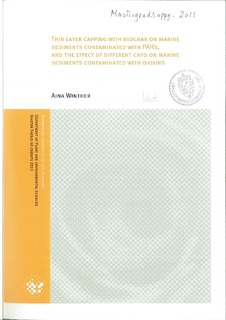| dc.description.abstract | Capping contaminated sediment with clean materials is a remediation method that has proved efficient. Passive capping materials physically isolate the contaminated sediment from the receiving environment and active materials sorb the contaminants, thereby making them inaccessible. Activated carbon is one active capping material that is effective in reducing the diffusion of contamination from the sediment. The objective of this thesis was to investigate if biochar could be applied as an active capping material in remediating contaminated sediment. The efficiency of different biochars in reducing PAH diffusion from contaminated sediment to the overlying water was examined by a diffusion experiment. Biochars produced at different temperatures and from different organic materials were used as caps to test which was the most effective. These were corn stover biochar produced at 600oC, and biochar produced from oak at 250oC, 400oC, and 650oC. Diffusion jars with PAH contaminated sediment were set up for 1) uncapped sediment, 2) sediment capped with biochar and clay, and 3) sediment capped with clay, using heptane as an infinite sink for diffusing PAHs. The experiment lasted for 101 days and during this time five measurements were carried out, providing a temporal scale. The results showed that the efficiency of the cap (oak 650 biochar) in reducing the diffusion of the PAHs fluorene, phenanthrene, and acenaphthene ranged from 77.2% to 88.1% compared to the uncapped sediment. The results showed very little difference among the biochar caps in the efficiency of retaining diffusing PAHs from the contaminated sediment. Diffusion of small PAHs exceeded the diffusion of larger PAHs, where most were not detectable. The ones that were detected measured very low concentrations, and diffusion of benzo(b)flouranthene represented the general trend for the detectable, large PAHs. Steady state diffusive flux of phenanthrene was reduced with 77 % for capped sediment (oak 650 cap) compared to uncapped sediment.
Sorption isotherms for the biochars were determined in order to check the strength of biochar sorption of PAHs. The isotherms were measured over four different concentrations of phenanthrene and pyrene and the biochar – water partitioning coefficient was calculated. The isotherms were presented as Freundlich isotherms. According to the results, the corn stover biochar had the most reliable data and therefore the most reliable isotherms for both phenanthrene and pyrene (Kbiochar for sorption of phenanthrene and pyrene to corn stover was 5.05 ml/g). Sorption of phenanthrene and pyrene to corn stover also had the highest n values, though these were highly below 1 (n = 0.38 for sorption of phenanthrene, n = 0.43 for sorption of pyrene). The biochar with the highest KFr value for sorption of phenanthrene was the oak 400 biochar (KFr = 7.05 (ng/kg)(ng/l)n), and oak 250 had the highest KFr value for pyrene sorption (KFr = 6.61(ng/kg)(ng/l)n) . KFr was not found for phenanthrene sorption to the oak 250 and oak 650 biochars, or for pyrene sorption to the oak 650 biochar. There was not enough reliable data for the oak 650 biochar to construct an isotherm. Another part of the thesis was to investigate thin layer capping with three different materials on dioxin contaminated sediment in the Grenland fjords, as a part of the Opticap project. Field work was conducted in the Ormerfjord and the Eidangerfjord in the Grenland fjords. The aim was to test the efficiency of the capping materials 1) activated carbon and clay, 2) crushed limestone, and 3) clay in order to reduce dioxin diffusion. According to the results, all caps were efficient in reducing the dioxin flux from the sediment, and the flux was the lowest in the crushed limestone field, though there are variations between the measurements. Dioxins in free aqueous phase were also reduced in the capped fields, but there were no clear trends in which cap was the most efficient, due to currents and exchange of sea water. The dioxin flux from the sediment was measured with semi-permeable membrane device (SPMD) and the dioxins in free aqueous phase were measured with polyoxymethylene (POM). The measurements were done by employing a flux chamber which was put on the sea floor and collected at different time points. | no_NO |
